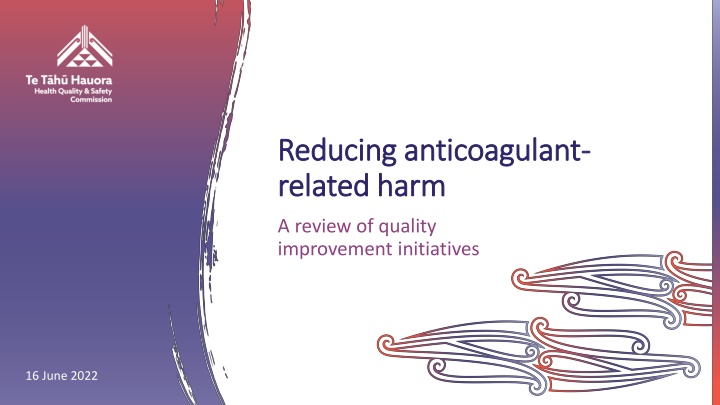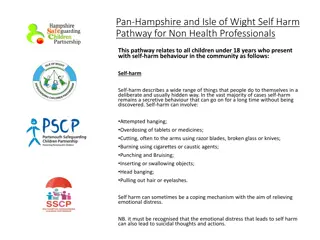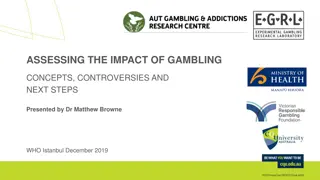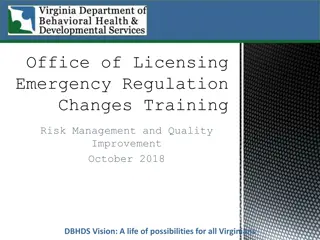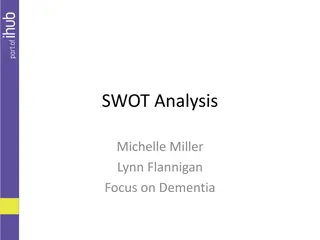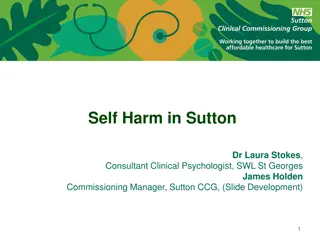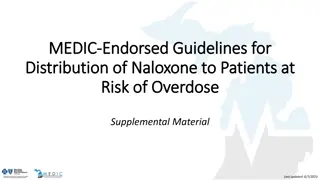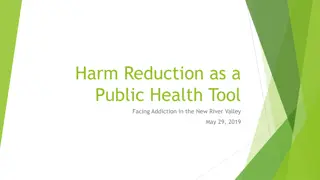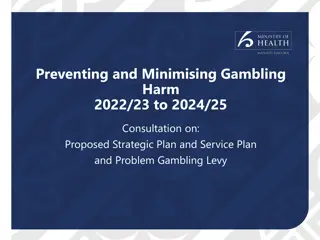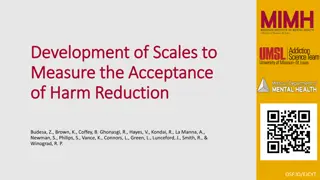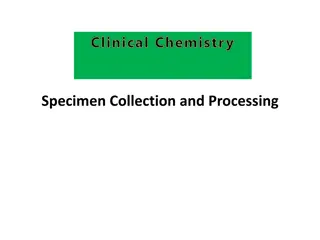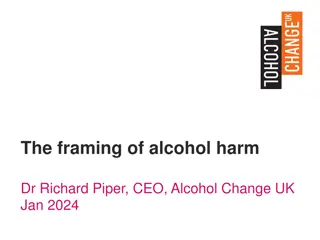Quality Improvement Initiatives for Reducing Anticoagulant-Related Harm: A Review
The review focuses on reducing harm associated with anticoagulant use through quality improvement initiatives. It discusses under- and over-utilization, inappropriate prescribing, and suboptimal management of adverse drug events. The project aims to identify literature, guidance, and improvement initiatives relevant to the safe use of anticoagulants. Findings include academic papers, stewardship programs, pharmacist interventions, and case studies, highlighting the importance of physician-led consultations, dosing nomograms, and pharmacist management in improving outcomes.
Download Presentation

Please find below an Image/Link to download the presentation.
The content on the website is provided AS IS for your information and personal use only. It may not be sold, licensed, or shared on other websites without obtaining consent from the author.If you encounter any issues during the download, it is possible that the publisher has removed the file from their server.
You are allowed to download the files provided on this website for personal or commercial use, subject to the condition that they are used lawfully. All files are the property of their respective owners.
The content on the website is provided AS IS for your information and personal use only. It may not be sold, licensed, or shared on other websites without obtaining consent from the author.
E N D
Presentation Transcript
Reducing anticoagulant Reducing anticoagulant- - related harm related harm A review of quality improvement initiatives 16 June 2022
Background Background Anticoagulants include unfractionated and low molecular weight heparins, vitamin K antagonists and direct oral anticoagulants (DOAC). Evidence of under- and over-utilisation, inappropriate prescribing, inappropriate labs, suboptimal management of adverse drug events, suboptimal care transitions and excessive adverse events including bleeding and thrombosis. Te T h Hauora is undertaking a quality improvement project with the aim of reducing harm from the use of anticoagulants. Work with the sector and survey of district quality and risk. Commissioned review of the evidence (this presentation supplements the full report).
Aims Aims To identify academic literature, institutional guidance and New Zealand quality improvement initiatives including systems, processes or practices relevant to the safe use of anticoagulants. Evidence since 2015 in the adult public hospital setting, where change or adjustment in anticoagulants, including reversal, treatment planning, procedure or surgery postponement and discharge. Seeking evidence-based quality improvement interventions and change ideas.
Method Method Evidence scan, non-systematic, targeted, time-limited search, complementing existing search by Manat Hauora. Three components: 1. Review of the academic literature since 2015 2. Review of advice published by international institutions 3. Survey of activities occurring at DHBs around Aotearoa New Zealand. PubMed, Cochrane, Google Scholar, MedRxiv and SafetyLit, Elicit . Institutional websites. Survey, email responses, key informant interviews (DHBs). DHB = district health board
Findings Findings 48 full-text academic papers retained Meta-analyses and reviews (n = 8) Anticoagulation stewardship (n = 6) Discharge and follow-up (n = 4) Pharmacist intervention (n = 11) EHR, e-prescribing, CDSS, apps (n = 8) Other (n = 4) Commentaries/consensus (n = 7). Institutional advice (n = 6). Case studies. New Zealand initiatives across 10 DHBs. EHR = electronic health records; CDSS = clinical decision support systems
Academic reviews Academic reviews Physician-led anticoagulation consultation services may reduce bleeding rates in high-risk patients: 58% lower (95% confidence interval 2 82%; p = 0.03). Dosing nomograms increased TTR (Frazer et al 2019). Pharmacist management: benefits in surrogate outcomes (eg, therapeutic range, length of stay, fewer drug interactions) and possible reduced mortality (Lee et al 2016). E-health interventions generally under-studied, limited benefits for: computerised physician order entry, CDSS, dashboard utilisation and EMR implementation in general (Austin et al 2020). EMR = electronic medical records; TTR = time in therapeutic range
Individual studies: Individual studies: Anticoagulation stewardship Anticoagulation stewardship Based on principles of antimicrobial stewardship. Multidisciplinary team and multicomponent approach: leadership, guidelines, protocols, anticoagulation services, medication review/reconciliation, staff education, patient counselling and measurement. Cost savings (Wychowski et al 2017).
Individual studies: Individual studies: Anticoagulation stewardship Anticoagulation stewardship Netherlands: greater adherence to guidelines (adjusted odds ratio 1.58, 95% confidence interval 1.21 2.05), reduced all-cause mortality odds ratio 0.72 (0.53 0.98), trend to reduced bleeding/ thrombosis, but not cause of death (Dreijer et al 2019, 2020). Australia: Reduction in VTE (33%) and anticoagulant-related bleeds (20%). However, no statistical analysis (Bui et al 2021). VTE = venous thromboembolism
Individual studies: Individual studies: Pharmacist interventions Pharmacist interventions Overall, most of the studies obtained indicate possible benefits of pharmacist involvement with patients taking anticoagulants. Pharmacist involvement in patient education increased awareness of the care plan, TTR and possibly reduces return to the emergency department, for example: Patients with pharmacist counselling and follow-up less likely to be readmitted to hospital or return to the ED within 90 days (12.1% vs 1.9%, p = 0.0069) (Zdyb et al 2017). ED = emergency department
Individual studies: Individual studies: Pharmacist interventions Pharmacist interventions Pharmacist prescribing, review, oversight (at pre- admission, diagnosis or discharge) associated with fewer medication errors or omissions, for example: Pharmacist DOAC review service, fall in inappropriate prescriptions from 34% to 13.8% (p = 0.039) (Miele, Taylor and Shah 2017).
Individual studies: Individual studies: Electronic solutions Electronic solutions Includes e-prescribing, EHR, CDSS and apps. Most studies did not report hard clinical outcomes, and were low-quality, uncontrolled, non- randomised studies.
Individual studies: Individual studies: Electronic solutions Electronic solutions Individual studies obtained indicated: electronic alerts may lead to improved prescribing quality, eg, study of 1,086 alerts, pharmacists generated an intervention 51% of the time (Ib ez-Garcia et al 2019) app-based guidance or electronic CDSS may be associated with fewer emergency department visits or decreased VTE rates, eg, CDSS was associated with decreased VTE (11.71 per 1,000 hospitalisations to 4.84, p = 0.0068) (Nazarenko et al 2015), app guidance fewer emergency department visits post-procedure (8.3% vs 4.0%, p = 0.02) (Spyropoulos et al 2020).
Individual studies: Individual studies: Discharge and follow Discharge and follow- -up up Lean Six Sigma approach (system alert) reduced omission of warfarin at discharge from 10.5% to 0% (p = 0.03). Other studies did not identify concrete benefits. Overall, little evidence identified for meaningful impact of the discharge protocols and follow-up regimens reported.
High High- -level consensus and commentary level consensus and commentary Most high-level statements obtained from academic literature related to the United States context: Joint Commission Resources to support NPSG.03.05.01 Anticoagulation Forum: organisations must undertake serial re-evaluation of their guidance (Dager et al 2020) haematologists to optimise individual patient care, as well as the overall system of health care delivery (May and Moll, 2019) NYSACTF consensus on features of electronic health records necessary to deliver optimised anticoagulation therapy (Spyropoulos et al 2015) NYSACTF consensus on 12 general data elements and 3 specific to warfarin, which should accompany all anticoagulated patients undergoing care transitions (Triller et al 2018). NYSACTF = New York State Anticoagulation Task Force
Institutional advice Institutional advice AHRQ: Making Healthcare Safer III (AHRQ, 2020): recommendation for pharmacist-provided anticoagulation management services (largely in the ambulatory care setting). Anticoagulation Forum produced the Anticoagulation stewardship guide (Anticoagulation Forum 2019): mentored implementation and dissemination of Anticoagulation Stewardship (MIDAS) programme pairs nationally recognised anticoagulation experts with hospitals. ISMP recommends that organisations use the ISMP medication safety self-assessment for antithrombotic therapy. AHRQ = Agency for Healthcare Research and Quality; ISMP = Institute for Safe Medication Practices
Case study: Case study: Erasmus University Medical Centre Erasmus University Medical Centre Antithrombotic stewardship programme: Multidisciplinary team: specialised thrombosis nurse (the case manager), haematologist, paediatric haematologists, hospital pharmacist, cardiologist, anaesthetist, pulmonary physician, neurologist, vascular surgeon and a quality officer. Provided hospital-wide education, medication reviews (included dosing, duplicate medication, drug drug interactions, contraindications and perioperative bridging), guidelines and policy, patient counselling, medication reconciliation, discharge pharmacotherapy advice/medication review to thrombosis service or GP, and community pharmacist.
Case study: Case study: Erasmus University Medical Centre Erasmus University Medical Centre Outcomes: Greater adherence to guidelines (adjusted odds ratio 1.58, 95% confidence interval 1.21 2.05). Composite endpoint of bleeding or thrombosis by three months after hospitalisation, trend of reducing by 1.83% per two months (Jan Dec 2017) following intervention (95% confidence interval -2.58 to -1.08). Reduced all-cause mortality odds ratio 0.72 (0.53 0.98), but not due to bleeding and thrombosis (Dreijer et al 2019, 2020).
Case study: Capital & Coast DHB Case study: Capital & Coast DHB Peri-procedure anticoagulation bridging service: wraparound peri-procedure service set up by professional agreement with all involved clinicians run by the hospital thrombosis service (includes specialist thrombosis nurses) individual bridging assessments including implementation of appropriate management, communication and education contact patients, provide key reminders, ensure documentation complete and manage a safe return to the previous anticoagulant.
Case study: Capital & Coast DHB Case study: Capital & Coast DHB Outcomes: overall incidence of major bleeding was 1.9% at day 30 rate of thrombosis was 0.8% figures compare favourably with the BRIDGE study where rates of bleeding were 1.3% in the no-bridging group and 3.2% in the bridging group (Ruell et al 2019).
Current initiatives Aotearoa New Zealand Current initiatives Aotearoa New Zealand Guidelines and protocols, however, many are ad hoc. Apps to guide use of anticoagulants. Ward round checklists. Alerts but not always integrated with relevant data. Education: PGY1/2, trainee interns. Warfarin bracelets. Separate medication charts. Specialist thrombosis services. Pharmacist rounding, often not systematic. Few audits or evaluations.
Discussion Discussion Evidence included surprisingly few high-quality studies, given the long history of anticoagulation- related harm. Nevertheless, three areas stand out as having the support of some evidence: expanding the role of pharmacists anticoagulation stewardship programmes improved use of the EHR and CDSS to support the above and facilitate efficient audit and evaluation.
Change ideas Change ideas Pharmacists: systematic use of pharmacist expertise, anticoagulation management services, pre-admission prescribing, ward round presence, input at diagnosis, discharge review (including ED prescriptions), daily review of alerts, patient education, other forms of pharmacist oversight. Anticoagulation stewardship: Multidisciplinary governance team, prioritise and integrate other solutions, eg, pharmacist input, referral to community anticoagulation management services, periprocedural bridging services, education, rollout of supporting e-prescribing, CDSS and audit tools.
Change ideas Change ideas Electronic solutions: Enhance impact of pharmacists and multidisciplinary stewardship, systematic implementation of electronic systems for prescribing, CDSS, daily reports, clinical-rule- based alerts, automated audit and evaluation for ongoing quality improvement.
How to implement anticoagulation How to implement anticoagulation stewardship: stewardship: Anticoagulation Forum Anticoagulation Forum Secure administrative leadership commitment: dedicate necessary human, financial and technology resources. Establish professional accountability and expertise: appoint a single leader responsible for programme outcomes, supported by at least one clinician with expertise in anticoagulation management. Engage multidisciplinary support: involve key specialists and disciplines to get perspective from all domains of the care delivery system. Perform data collection, tracking and analysis: define the population, objectively evaluate performance and guide decision-making.
How to implement anticoagulation How to implement anticoagulation stewardship: stewardship: Anticoagulation Forum Anticoagulation Forum Implement systematic care: implement sustainable, efficient, evidence-based action(s) at the system level to assure the safety and quality of anticoagulation management. Facilitate transitions of care: create systems to optimise communication and ensure safe transitions between care settings. Advance education, comprehension and competency: assure that clinicians, patients and others have the knowledge and skills necessary to optimise outcomes.
How to implement anticoagulation How to implement anticoagulation stewardship stewardship See also Dane et al 2022 for step-by-step guidance. Checklist for Core Elements of Anticoagulation Stewardship Programmes (Anticoagulation Forum 2019).
Key references Key references Agency for Healthcare Research and Quality. 2020. Making Healthcare Safer III: A critical analysis of existing and emerging patient safety practices. Rockville, MD: AHRQ. URL: https://www.ahrq.gov/research/findings/making-healthcare-safer/mhs3/index.html Anticoagulation Forum. 2019. Core Elements of Anticoagulation Stewardship Programmes. Newton, MA: Anticoagulation Forum. URL: https://acforum.org/web/education- stewardship.php Austin J, Barras M, Sullivan C. 2020. Interventions designed to improve the safety and quality of therapeutic anticoagulation in an inpatient electronic medical record. International Journal of Medical Informatics 135: 104066. DOI: 10.1016/j.ijmedinf.2019.104066. Bui T, Bortz H, Cairns KA, et al. 2021. AAA stewardship: managing high-risk medications with dedicated antimicrobial, anticoagulation and analgesic stewardship programs. Journal of Pharmacy Practice and Research 51: 342 7. DOI: 10.1002/jppr.1716. Dager WE, Ansell J, Barnes GD, et al. 2020. Reduce the likelihood of patient harm associated with the use of anticoagulant therapy : Commentary from the Anticoagulation Forum on the Updated Joint Commission NPSG.03.05.01 Elements of Performance. The Joint Commission Journal on Quality and Patient Safety 46: 173 80. DOI: 10.1016/j.jcjq.2019.12.004. Dane KE, Naik RP, Streiff MB, et al. 2022. Hemostatic and antithrombotic stewardship programs: A toolkit for program implementation. Journal of the American College of Clinical Pharmacy 5(6): 622 31. DOI: 10.1002/jac5.1614. Dreijer AR, Diepstraten J, Leebeek FWG, et al. 2019. The effect of hospital-based antithrombotic stewardship on adherence to anticoagulant guidelines. International Journal of Clinical Pharmacy 41(3): 691 9. DOI: 10.1007/s11096-019-00834-2. Dreijer AR, Kruip M, Diepstraten J, et al. 2020. Effect of antithrombotic stewardship on the efficacy and safety of antithrombotic therapy during and after hospitalization. PLoS One. 15(6): e0235048. DOI: 10.1371/journal.pone.0235048. Frazer A, Rowland J, Mudge A, et al. 2019. Systematic review of interventions to improve safety and quality of anticoagulant prescribing for therapeutic indications for hospital inpatients. European Journal of Clinical Pharmacology 75(12): 1645 57. DOI: 10.1007/s00228-019-02752-8. Ib ez-Garcia S, Rodriguez-Gonzalez C, Escudero-Vilaplana V, et al. 2019. Development and evaluation of a clinical decision support system to improve medication safety. Applied Clinical Informatics 10(3): 513 20. DOI: 10.1055/s-0039-1693426. Lee T, Davis E, Kielly J. 2016. Clinical impact of a pharmacist-led inpatient anticoagulation service: a review of the literature. Integrated Pharmacy Research and Practice 5: 53 63. DOI: 10.2147/iprp.S93312. May J, Moll S. 2019. Reducing the likelihood of harm associated with use of anticoagulant therapy. The Hematologist 16(6). DOI: 10.1182/hem.V16.6.9935. Miele C, Taylor M, Shah A. 2017. Assessment of direct oral anticoagulant prescribing and monitoring pre- and post-implementation of a pharmacy protocol at a community teaching hospital. Hospital Pharmacy 52(3): 207 13. DOI: 10.1310/hpj5203-207. Nazarenko GI, Kleymenova EB, Payushik SA, et al. 2015. Decision support systems in clinical practice: The case of venous thromboembolism prevention. The International Journal of Risk & Safety in Medicine 27 Suppl 1: S104 5. DOI: 10.3233/jrs-150709. Ruell J, Smith A, Perera T, et al. 2019. The role of a specialist bridging service. A New Zealand prospective study of 600 patients. Journal of Thrombosis and Haemostasis 17(10): 1756 61. DOI: 10.1111/jth.14542. Spyropoulos AC, Viscusi A, Singhal N, et al. 2015. Features of electronic health records necessary for the delivery of optimized anticoagulant therapy: consensus of the EHR Task Force of the New York State Anticoagulation Coalition. Annals of Pharmacotherapy 49(1): 113 24. DOI: 10.1177/1060028014555176. Spyropoulos AC, Giannis D, Cohen J, et al. 2020. Implementation of the management of anticoagulation in the periprocedural period app into an electronic health record: a prospective cohort study. Clinical and Applied Thrombosis/Hemostasis 26: 1076029620925910. DOI: 10.1177/1076029620925910. Triller D, Myrka A, Gassler J, et al. 2018. Defining minimum necessary anticoagulation-related communication at discharge: consensus of the care transitions task force of the New York State Anticoagulation Coalition. The Joint Commission Journal on Quality and Patient Safety 44(11): 630 40. DOI: 10.1016/j.jcjq.2018.04.015. Wychowski MK, Ruscio CI, Kouides PA, et al. 2017. The scope and value of an anticoagulation stewardship program at a community teaching hospital. Journal of Thrombosis and Thrombolysis 43(3): 380 6. DOI: 10.1007/s11239-016-1455-z. Zdyb EG, Courtney DM, Malik S, et al. 2017. Impact of discharge anticoagulation education by emergency department pharmacists at a tertiary academic medical center. The Journal of Emergency Medicine 53(6): 896 903. DOI: 10.1016/j.jemermed.2017.06.008.
